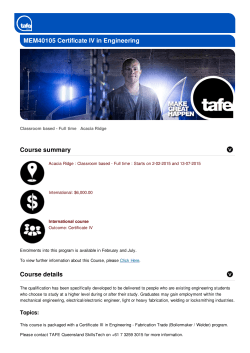
PDF - CIDAR at Boston University
Accessible Microfluidic Mold Fabrication Using 3D Printing Aaron Heuckroth, Cassie Huang, Ryan Silva, Sonya Iverson, Traci Haddock, Alan Pacheco, Douglas Densmore Electrical and Computer Engineering Dept., Boston University Introduction Flexible microfluidic devices offer biologists the ability to analyze and affect biological systems in controlled, repeatable ways. Fabrication Process Usage Example A transposer element has the ability to selectively swap the contents of two channels, allowing the user to route fluids through the chip dynamically while maintaining continuous flow. 1. Design your device These devices are commonly fabricated by designing, ordering, and casting from photolithographic molds, a process that requires a significant investment in time, specialized equipment, and personnel training. Python scripts are used to place primitive features and configure device layers. “Flipped” layers will be automatically inverted, to be printed upside-down. We present an alternative fabrication process which uses inexpensive Fused Deposition Modeling (FDM) 3D printers A to produce molds in minutes and at minimal cost, in which we use free, open-source software to design and produce molds with complex internal geometry from simple, parameterized components. This process removes significant barriers of cost, time, and expertise from the fabrication of microfluidic devices. This makes it easier for researchers to adopt and experiment with this technology, and facilitates the rapid prototyping, refinement, and sharing of device designs within the synthetic biology community. To demonstrate the use of this system, we designed and fabricated molds for a theoretical microfluidic transposer element. hello_device.py This design requires that one channel “jump” over another by traversing between the flow and control layers. While difficult to fabricate using conventional photolithography techniques, our molding process allows these transverse features to be cast easily in a single step. These scripts generate OpenSCAD files for each layer of the device, as well as an overall structural mockup. Subsequent steps require only minimal, “drag-and-drop” software interaction. An initial prototype was designed and fabricated using our process. We then refined the design over the course of a week to dramatically reduce both individual feature size and the device’s overall footprint. 2. Compile 3D geometry hello_device_MOCKUP.scad hello_device_flow.scad Hello_device_control.scad An OpenSCAD library creates printable 3D models for each layer. Each OpenSCAD file contains a list of primitives and parameters that determine the structure and placement of features in that layer. Materials and Software Size: 61 x 36 x 4 mm Volume: 1 cm3 Footprint: 22 cm2 Channel Width: 2mm Channel Height: .5mm Size: 19 x 12 x 1.2 mm Volume: 30 mm3 Footprint: 2.27 cm2 Channel Width: .2 mm Channel Height: .1 mm Size: 14 x 14 x 1.2 mm Volume: 30 mm3 Footprint: 1.86 cm2 Channel Width: .2 mm Channel Height: .1 mm 3. Slice layer models into G-code This process will work with nearly all G-code compatible FDM printers, since feature sizes can be optimized for the capabilities of the target printer during initial device design. Slic3r is used to slice each 3D model into G-code instructions based on nozzle size, minimum layer height, and other printerspecific factors. You need... We used… An FDM 3D Printer Filament Hairspray 2x3” Glass Slides Printrbot Simple Metal Gizmodorks White PLA Consort (Extra Hold) C&A Sci. 6101 Price at $600* $25/kg $5/can $.10/per 4. Print separate layers onto glass slides • Instructional guides and videos on our process and workflow • Easy and inexpensive procedures for casting PDMS devices from 3D printed molds • Interlocking features that aid in XYZ alignment during PDMS casting OpenSCAD is a procedural solid-body modeler. We use it to create the models for our device designs because it lets us turn code into 3D-printable objects. Get it at openscad.org Octoprint Octoprint is a host application that provides a web interface for remotely controlling and monitoring a 3D printer. We use it to run all of CIDAR’s 3D printers because of its convenience and compatibility with almost all FDM printers. Get it at octoprint.org Source code is publicly available for this project and all examples shown on this poster. If you try it out, please let us know! Get it at github.com/CIDARLAB/3DuF *We upgraded our printer with a heated bed, an ATX power supply, and a .2mm nozzle from printrbot.com. ($200) Control We are currently working on… Python is an object-oriented programming language. We use it to create designs for microfluidic device molds because it’s powerful and easy to use. Get it at python.org Slic3r Flow Future Work All software used in our fabrication process is free, open-source, and totally awesome. Slic3r is a G-code generator for 3D printers. We use it to convert our 3D mold models into the instructions that run our printer because it handles tiny features well and will work with almost all FDM printers. Get it at slic3r.org The result is a parametric transposer module that can be easily customized and adapted for fabrication at a wide range of feature sizes. • Printable chip-to-world interfaces that can be generated in tandem with devices Slide holders are printed in situ, ensuring proper X/Y feature positioning. Once the holders are finished, the print pauses automatically and glass slides are inserted. Hairspray is applied at 65°C, improving slide surface adhesion and mitigating imperfect z-axis calibration. The print is resumed, and mold features are printed directly onto the surface of each slide. 5. Assemble layers for PDMS casting The standardized slide shape provides X/Y alignment. “Standoff” primitives can be used to fix the Z distance between layers, such as for preserving the thickness of valve membranes. • Electronics, software, and hardware for automated microfluidic device control. • Improved process automation, removing manual OpenSCAD and Slic3r interaction. • Integration with Fluigi (cidarlab.org/fluigi/) for initial device design and routing Copyright ©Aaron Heuckroth, 2015 This mold was fabricated in less than 15 minutes at a cost of $0.25. Special thanks to Carlo Quinonez, PhD and the Bio/Nano/Programmable Matter group at Autodesk, Inc. for advice and inspiration regarding 3D-printable bioelectronic devices.
© Copyright 2025















